brake light Citroen C5 RHD 2015 (RD/TD) / 2.G Owner's Manual
[x] Cancel search | Manufacturer: CITROEN, Model Year: 2015, Model line: C5 RHD, Model: Citroen C5 RHD 2015 (RD/TD) / 2.GPages: 344, PDF Size: 12.96 MB
Page 4 of 344
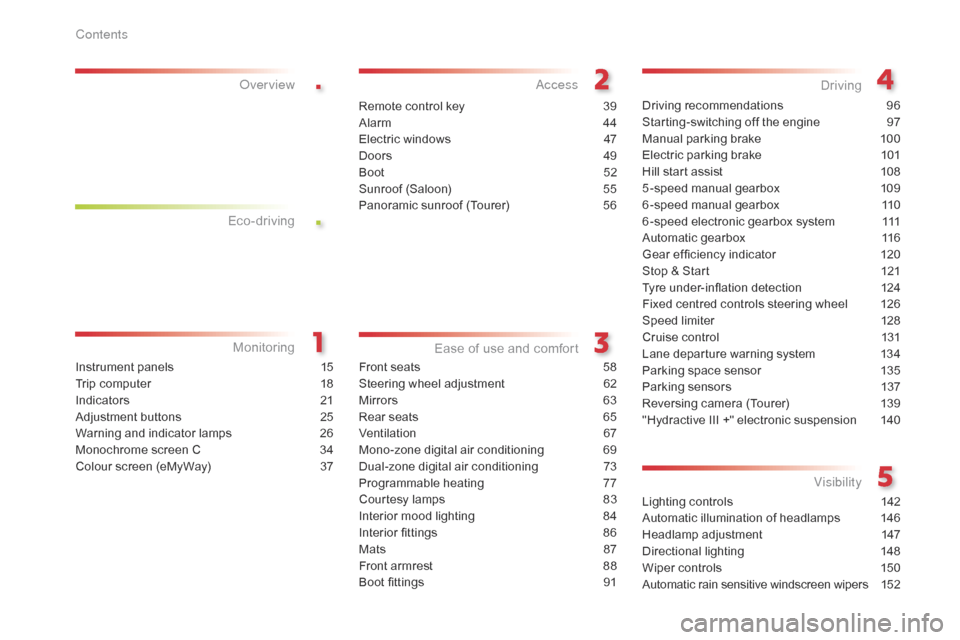
.
.
Instrument panels 15
Trip computer
1
8
Indicators
21
A
djustment buttons
2
5
Warning and indicator lamps
2
6
Monochrome screen C
3
4
Colour screen (eMyWay)
3
7
over view
Front seats 58
Steering wheel adjustment
6
2
Mirrors
6
3
Rear seats
6
5
Ventilation
6
7
Mono-zone digital air conditioning
6
9
Dual-zone digital air conditioning
7
3
Programmable heating
7
7
Courtesy lamps
8
3
Interior mood lighting
8
4
Interior fittings
8
6
Mats
87
F
ront armrest
8
8
Boot fittings
9
1Driving recommendations
9
6
Starting-switching off the engine
9
7
Manual parking brake
1
00
Electric parking brake
1
01
Hill start assist
1
08
5 -speed manual gearbox
1
09
6 -speed manual gearbox
1
10
6 -speed electronic gearbox system
1
11
Automatic gearbox
1
16
Gear ef ficiency indicator
1
20
Stop & Start
1
21
Tyre under-inflation detection
1
24
Fixed centred controls steering wheel
1
26
Speed limiter
1
28
Cruise control
1
31
Lane departure warning system 1 34
Parking space sensor 1 35
Parking sensors
1
37
Reversing camera (Tourer)
1
39
"Hydractive III +" electronic suspension
1
40
Lighting controls
1
42
Automatic illumination of headlamps
1
46
Headlamp adjustment
1
47
Directional lighting
1
48
Wiper controls
1
50
Automatic rain sensitive windscreen wipers
1
52
Eco-drivingMonitoring
a
ccess
Ease of use and comfort Driving
Visibility
Remote control key 3 9
Alarm
4
4
Electric windows
4
7
Doors
4
9
Boot
5
2
Sunroof (Saloon)
5
5
Panoramic sunroof (Tourer)
5
6
Contents
Page 6 of 344
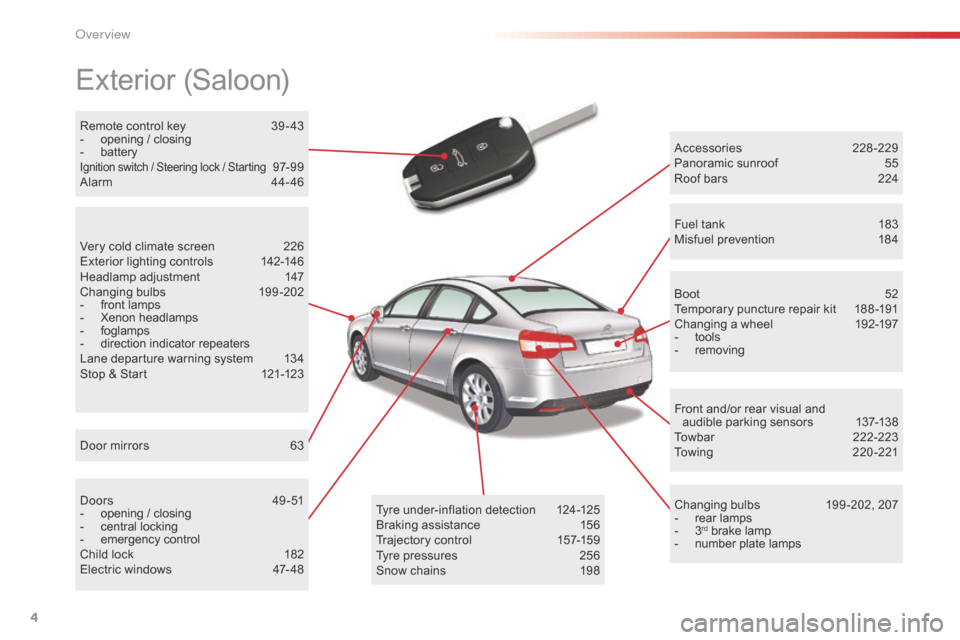
4
Exterior (Saloon)
Accessories 228-229
Panoramic sunroof 5 5
Roof bars
2
24
Changing bulbs
1
99 -202, 207
-
rear lamps
-
3rd brake lamp
-
number plate lamps
Boo
t
5
2
Temporary puncture repair kit
1
88 -191
Changing a wheel
1
92-197
-
tools
-
removing
T
yre under-inflation detection
1
24-125
Braking assistance
1
56
Trajectory control
1
57-159
Tyre pressures
2
56
Snow chains
1
98 Fuel tank
1
83
Misfuel prevention
1
84
Remote control key
3
9 - 43
-
opening / closing
-
batteryIgnition switch / Steering lock / Starting 97- 9 9
Alarm 4 4- 46
Door mirrors
6
3
Very cold climate screen
2
26
Exterior lighting controls
1
42-146
Headlamp adjustment
1
47
Changing bulbs
1
99-202
-
front lamps
-
Xenon headlamps
-
foglamps
-
direction indicator repeaters
L
ane departure warning system
1
34
Stop & Start
1
21-123
D o o r s
4
9 - 51
-
opening / closing
-
central locking
-
emergency control
C
hild lock
1
82
Electric windows
4
7- 48 Front and/or rear visual and
audible
parking sensors
1
37-138
Towbar
2
22-223
Towing
2
20-221
O
Page 8 of 344
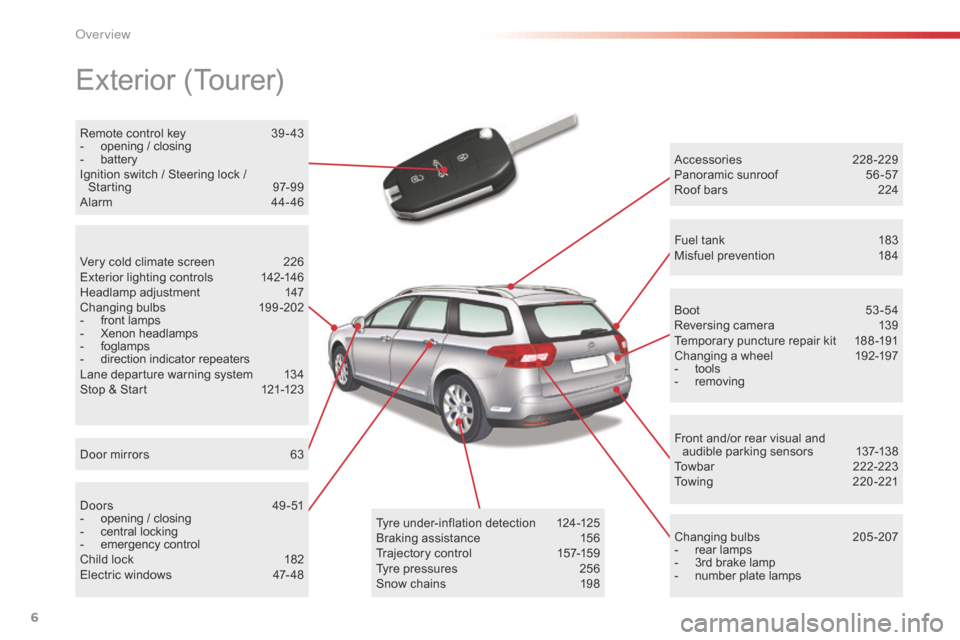
6
Exterior (Tourer)
Accessories 228-229
Panoramic sunroof 5 6 -57
Roof bars
2
24
Changing bulbs
2
05-207
-
rear lamps
-
3rd brake lamp
-
number plate lamps
Boo
t
5
3-54
Reversing camera
1
39
Temporary puncture repair kit
1
88 -191
Changing a wheel
1
92-197
-
tools
-
removing
T
yre under-inflation detection
1
24-125
Braking assistance
1
56
Trajectory control
1
57-159
Tyre pressures
2
56
Snow chains
1
98
Remote control key
3
9 - 43
-
opening / closing
-
battery
I
gnition switch / Steering lock / Starting
9
7-99
Alarm
4
4- 46 Fuel tank
1
83
Misfuel prevention
1
84
Door mirrors
6
3
Very cold climate screen
2
26
Exterior lighting controls
1
42-146
Headlamp adjustment
1
47
Changing bulbs
1
99-202
-
front lamps
-
Xenon headlamps
-
foglamps
-
direction indicator repeaters
L
ane departure warning system
1
34
Stop & Start
1
21-123
D o o r s
4
9 - 51
-
opening / closing
-
central locking
-
emergency control
C
hild lock
1
82
Electric windows
4
7- 48 Front and/or rear visual and
audible
parking sensors
1
37-138
Towbar
2
22-223
Towing
2
20-221
O
Page 9 of 344
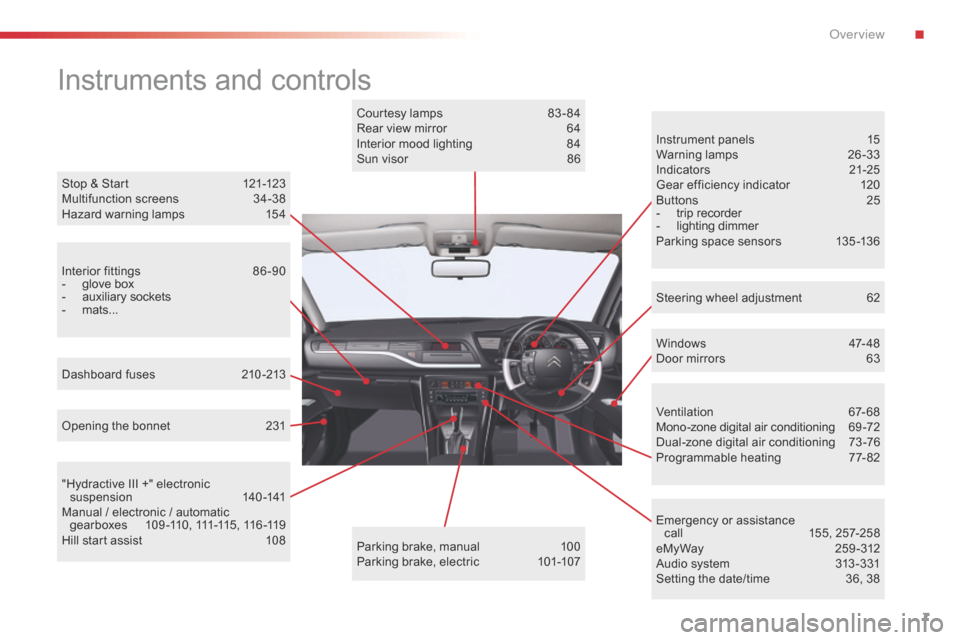
7
Instruments and controls
Instrument panels 15
Warning lamps 2 6-33
Indicators
2
1-25
Gear efficiency indicator
1
20
Buttons
2
5
-
trip recorder
-
lighting dimmer
P
arking space sensors
1
35 -136
Windows
4
7- 48
Door mirrors
6
3
Opening the bonnet
2
31
Dashboard fuses
2
10 -213
"Hydractive III +" electronic suspension
14
0 -141
Manual / electronic / automatic g e a r b o x e s
1
0 9 -11 0 , 111 -115 , 11 6 -11 9
Hill start assist
1
08 Courtesy lamps
8
3 - 84
Rear view mirror
6
4
Interior mood lighting
8
4
Sun visor
8
6
Parking brake, manual
1
00
Parking brake, electric
1
01-107
Stop & Start
1
21-123
Multifunction screens
3
4-38
Hazard warning lamps
1
54
Ventilation
6
7-68
Mono-zone digital air conditioning
6
9 -72
Dual-zone digital air conditioning
7
3-76
Programmable heating
7
7-82
Emergency or assistance call
1
55, 257-258
e My Way
2
59 - 312
Audio system
3
13 -331
Setting the date/time
3
6, 38
Steering wheel adjustment
6
2
Interior fittings
8
6 -90
-
glove box
-
auxiliary sockets
-
mats...
.
O
Page 15 of 344
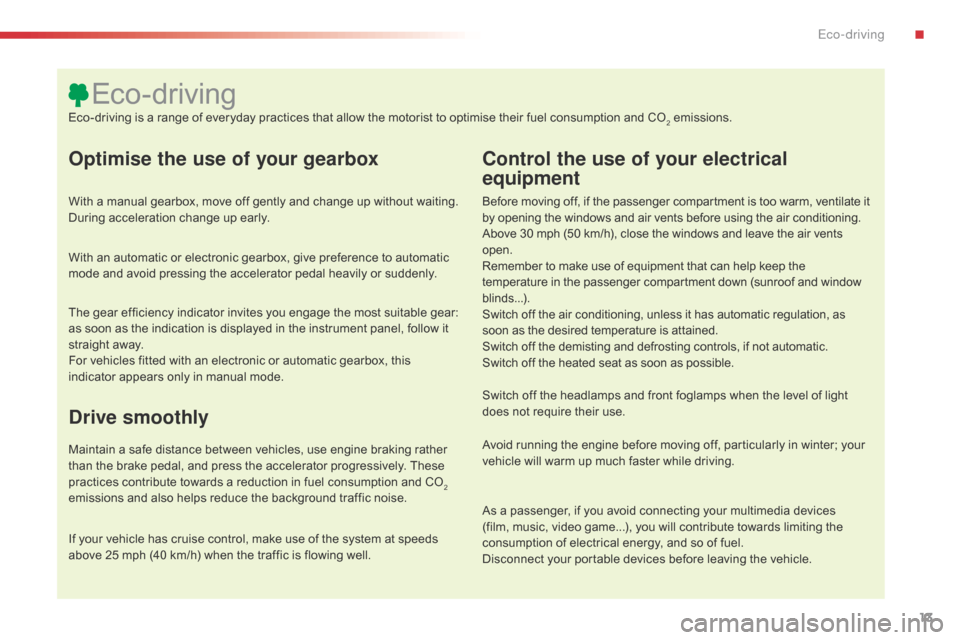
13
Optimise the use of your gearbox
With a manual gearbox, move off gently and change up without waiting.
During acceleration change up early.
With an automatic or electronic gearbox, give preference to automatic
mode and avoid pressing the accelerator pedal heavily or suddenly.
Control the use of your electrical
equipment
Before moving off, if the passenger compartment is too warm, ventilate it
by opening the windows and air vents before using the air conditioning.
Above 30 mph (50 km/h), close the windows and leave the air vents
open.
Remember to make use of equipment that can help keep the
temperature in the passenger compartment down (sunroof and window
blinds...).
Switch off the air conditioning, unless it has automatic regulation, as
soon as the desired temperature is attained.
Switch off the demisting and defrosting controls, if not automatic.
Switch off the heated seat as soon as possible.
Switch off the headlamps and front foglamps when the level of light
does not require their use.
Avoid running the engine before moving off, particularly in winter; your
vehicle will warm up much faster while driving.
As a passenger, if you avoid connecting your multimedia devices
(film, music, video game...), you will contribute towards limiting the
consumption of electrical energy, and so of fuel.
Disconnect your portable devices before leaving the vehicle.
Eco-driving
Eco-driving is a range of everyday practices that allow the motorist to optimise their fuel consumption and CO2 emissions.
The gear efficiency indicator invites you engage the most suitable gear:
as soon as the indication is displayed in the instrument panel, follow it
straight away.
For vehicles fitted with an electronic or automatic gearbox, this
indicator appears only in manual mode.
Drive smoothly
Maintain a safe distance between vehicles, use engine braking rather
than the brake pedal, and press the accelerator progressively. These
practices contribute towards a reduction in fuel consumption and CO
2
emissions and also helps reduce the background traffic noise.
If your vehicle has cruise control, make use of the system at speeds
above 25 mph (40 km/h) when the traffic is flowing well.
.
Eco-driving
Page 19 of 344

17
"Access to the vehicle"
Once you have selected this menu, you can:
F A ctivate/deactivate the driver's welcome
lighting function.
F
S
elect unlocking of all the doors or just the
driver's door.
F
A
ctivate/deactivate automatic operation of
the electric parking brake.
"Lighting"
Once you have selected this menu, you can:
F A ctivate/deactivate the lighting of the
daytime running lamps*.
F
A
ctivate/deactivate the guide-me-home
lighting and adjust its duration.
F
A
ctivate/deactivate the dual-function
Xenon directional headlamps.
* Depending on country of sale.
"Driving aid"
Once you have selected this menu, you can:
F A ctivate/deactivate the operation of the
rear wiper when in reverse gear.
1
Monitoring
Page 34 of 344
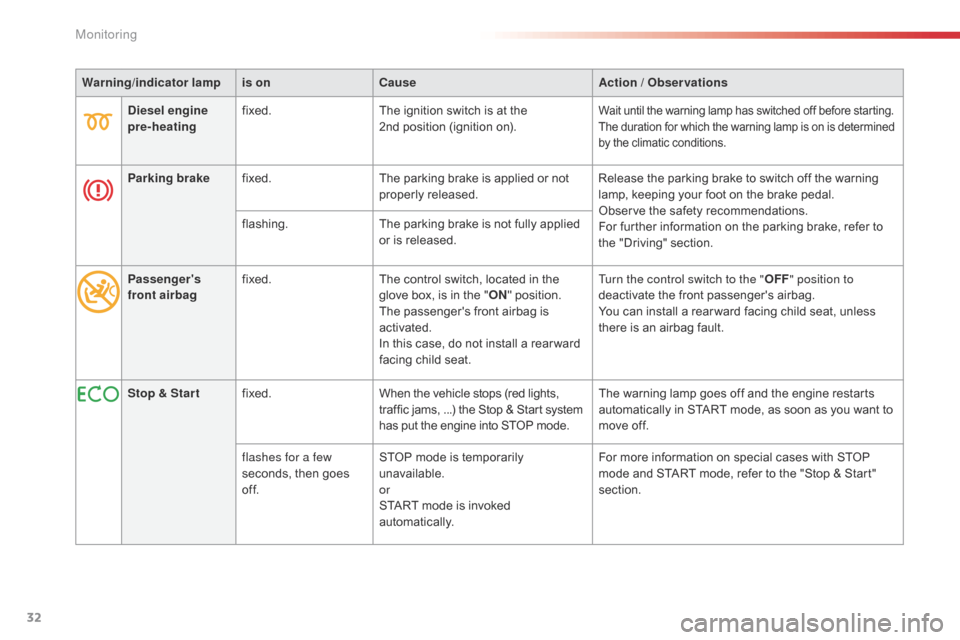
32
Warning/indicator lampis on Cause Action / Observations
Diesel engine
pre-heating fixed.
The ignition switch is at the
2nd
position (ignition on).
Wait until the warning lamp has switched off before starting.
The duration for which the warning lamp is on is determined
by the climatic conditions.
Parking brakefixed. The parking brake is applied or not
properly released. Release the parking brake to switch off the warning
lamp, keeping your foot on the brake pedal.
Observe the safety recommendations.
For further information on the parking brake, refer to
the "Driving" section.
flashing.
The parking brake is not fully applied
or is released.
Passenger's
front airbag fixed.
The control switch, located in the
glove box, is in the "ON" position.
The passenger's front airbag is
activated.
In this case, do not install a rear ward
facing child seat. Turn the control switch to the "
OFF" position to
deactivate the front passenger's airbag.
You can install a rear ward facing child seat, unless
there is an airbag fault.
Stop & Star t fixed. When the vehicle stops (red lights,
traffic jams, ...) the Stop & Start system
has put the engine into STOP mode. The warning lamp goes off and the engine restarts
automatically in START mode, as soon as you want to
move off.
flashes for a few
seconds, then goes
of f. STOP mode is temporarily
unavailable.
or
START mode is invoked
automatically. For more information on special cases with STOP
mode and START mode, refer to the "Stop & Start"
section.
Monitoring
Page 98 of 344

96
A few driving recommendations
Driving on flooded roads
We strongly advise against driving on flooded
roads, as this could cause serious damage
to the engine or gearbox, as well as to the
electrical systems of your vehicle. Observe the driving regulations at all times and
remain vigilant whatever the traffic conditions.
Pay close attention to the traffic and keep your
hands on the wheel so that you are ready to
react at any time to any eventuality.
On a long journey, a break every two hours is
strongly recommended.
In difficult weather, drive smoothly, anticipate
the need to brake and increase the distance
from other vehicles.
Important!
Never drive with the parking brake
applied - Risk of overheating and
damage to the braking system!
Do not park or run the engine when
stationary in areas where inflammable
substances and materials (dry grass,
dead leaves...) might come into contact
with the hot exhaust system - Risk of
fire!
Never leave a vehicle unsupervised
with the engine running. If you have
to leave your vehicle with the engine
running, apply the parking brake
and put the gearbox into neutral or
position
N or P, depending on the type
of gearbox.
If you are obliged to drive through water:
-
c
heck that the depth of water does not
exceed 15 cm, taking account of waves
that might be generated by other users,
-
d
eactivate the Stop & Start system,
-
d
rive as slowly as possible without
stalling. In all cases, do not exceed 6 mph
(10
km/h),
-
d
o not stop and do not switch off the
engine.
On leaving the flooded road, as soon as
circumstances allow, make several light brake
applications to dry the brake discs and pads.
If in doubt on the state of your vehicle, contact
a CITROËN dealer or a qualified workshop.
Driving
Page 123 of 344

121
Stop & Start
Operation
- with an electronic gearbox, at speeds
below 4 mph (6 km/h), press the brake
pedal or put the gear lever in position N .
Going into engine STOP
mode
The "ECO" warning lamp comes
on in the instrument panel and the
engine goes into standby:
If your vehicle is fitted with the
system, a time counter calculates
the sum of the periods in STOP
mode during a journey. It rests itself
to zero every time the ignition is
switched on with the key.
Special cases: STOP mode not
available
In this case, the "ECO" warning
lamp flashes for a few seconds then
goes
off.
This operation is perfectly normal. STOP mode is not invoked when:
-
t
he driver's door is open,
-
t
he driver's seat belt is not fastened,
-
t
he vehicle has not exceeded 6 mph
(10 km/h) since the last engine start using
the key,
-
t
he electric parking brake is applied or
being applied,
-
t
he engine is needed to maintain a
comfortable temperature in the passenger
compartment,
-
d
emisting is active,
-
s
ome special conditions (battery charge,
engine temperature, braking assistance,
ambient temperature...) where the engine is
needed to assure control of a system.
The Stop & Start
system puts the engine temporarily into standby - STOP mode - during stops in the traffic (red lights, traffic jams, or other...).
The
engine restarts automatically - START mode - as soon as you want to move off. The restart takes place instantly, quickly and silently.
Per fect for urban use, the Stop & Start system reduces fuel consumption and exhaust emissions as well as the noise level when stationary.
Never refuel with the engine in STOP
mode; you must switch off the ignition
with the key. For your comfort, during parking
maoeuvres, STOP mode is not
available for a few seconds after
coming out of reverse gear.
STOP mode does not affect the
functionality of the vehicle, such as for
example, braking, power steering...
4
driving
Page 134 of 344

132
Overriding the programmed
speed
While cruise control is in operation, it is always
possible to go above the programmed speed
simply by pressing the accelerator pedal (for
example to overtake another vehicle).
The speed displayed in zone A flashes.
You only have to release the accelerator pedal
to return to the programmed speed.
Programming
The selection is confirmed by the display of the
function in zone A of the instrument panel.
When the function is selected, no cruising
speed has yet been memorised.
Once the desired speed has been reached
using the accelerator, press button 1 or
button
2.
The cruising speed is then memorised
and cruise control is activated. The cruising
speed is displayed in zone A of the instrument
panel, and "ON" is displayed.
Adjustment of the
memorised speed while
cruise control is in
operation
You can adjust the memorised speed,
displayed in zone A , by pressing:
-
B
utton 1 to increase the speed.
-
B
utton 2 to reduce the speed.
Successive presses will modify the cruise
speed in steps of 1 mph and a continuous
press in steps of 5 mph.
You can then release the accelerator pedal.
The vehicle will automatically keep to the speed
chosen.
The vehicle speed may vary slightly from that
memorised.
If during cruise control the system cannot keep
to the cruise speed (e.g. on a steep descent),
then the speed flashes. If necessary, brake to
curb your speed.
F
P
ress button 4 to select cruise control
mode " CRUISE ".
Driving